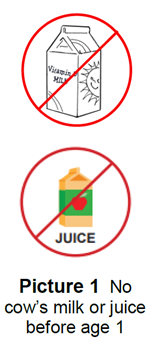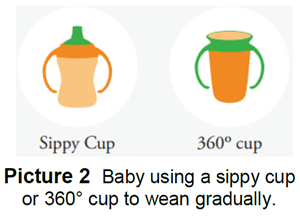Weaning Your Baby: Cup Feeding

Weaning is when your baby learns to drink from a cup instead of a breast or bottle. They should be drinking liquids from a cup by age 1. The longer you wait, the harder it can be for your child to give up the bottle. Drinking from a bottle for a long time after teeth have come in, can lead to tooth decay (cavities). If a baby drinks from a bottle while lying down for a long time, it can cause ear infections.

If you wean your baby from breastfeeding before 1 year of age, give them formula. They do not need other drinks for a healthy diet. You can offer a little water with food starting at 6 months to 1 year of age but give no more than ½ to 1 cup (4 to 8 ounces) a day. They should not drink cow’s milk or juice before age 1 (Picture 1). Breastfeeding can continue past that age.
When to Start
- The age of weaning is different for each baby.
- Most babies are ready to start learning to use a cup at 6 to 9 months of age. This is the same time they start to eat solid food.
- They need to be able to sit up without support in order to drink from a cup.
- Other signs of when your baby may be ready are when they:
- Shorten their breastfeeding time
- Are easily distracted while being held for a feeding
- Want to hold the bottle on their own
How to Begin
- At about 6 months of age, give your baby an empty, open sippy or 360° cup with handles to hold (Picture 2). Have them practice holding the cup when sitting at a table for a meal. Choose the same meal every day. It does not matter which one.

- Show your baby how you drink from your own cup. Ask them to copy you using theirs. Do not share your cup with them to prevent passing on your germs.
- Wean gradually. By 9 months, start to put a little bit of breastmilk or formula in their cup. You might need to help them hold the cup. They may resist drinking from the cup the first few times. It will take time for your baby to learn. They might make a mess.
- Do not offer them the bottle during or right after the meal when using the cup. When your child can drink from the cup, replace a second breastfeeding or bottle feeding with a cup feeding. This may take a few days or weeks for some children.
- Keep replacing breastfeeding or bottle feedings until your baby is no longer feeding from the bottle or breast.
- Let your child use a sippy cup only while sitting. A sippy cup should not be carried around by your child in their mouth. This can cause injury to the mouth if they fall.
- Switch to a cup with a lid, but no spout, as soon as possible. This will prevent possible problems in how their teeth grow. Aim for 18 months of age.
- Shift to a cup without any lid between age 2 and 3. By age 3 your child should be weaned from a sippy cup. While sippy cups help to avoid messy spills, drinking from them for too long can become a hard habit to give up.
Other Tips
- Avoid giving your baby a bottle or use breastfeeding to comfort them when crying or to help them fall asleep. This will make it harder for them to switch to only using a cup. Also, drinking just before sleeping can cause tooth decay.
- Offer only water between meals.
Weaning in One Step
The longer a child uses a bottle, the harder it may be for them to give it up. If your child can already drink from a cup but refuses to do so or refuses to give up the bottle, you might have to take away all bottles completely at one time. This method applies to children 15 to 18 months and older who use the bottle for comfort or habit and not for food.
To use this method:
- Remove all bottles from the home.
- Be firm and consistent about giving milk from a cup, not a bottle.
If you have any questions, be sure to ask your child’s dentist or health care provider.
Weaning Your Baby: Cup Feeding (PDF), Arabic (PDF), Nepali (PDF), Somali (PDF), Spanish (PDF)
HH-IV-19 6/87, Revised 2/22 Copyright 1987- 2022, Nationwide Children's Hospital
